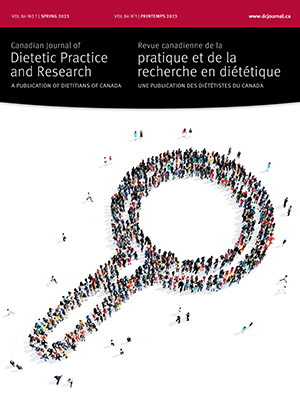Abstract
Purpose: Describe food/beverage intake among all patients and those with low meal intake and determine if the Hospital Food Experience Questionnaire (HFEQ), or its shorter version (HFEQ-sv), predicts food intake while considering patient (e.g., gender) and hospital characteristics (e.g., foodservice model).
Methods: Cross-sectional study of 1087 adult patients from 16 hospitals in Ontario, Canada. The valid and reliable HFEQ assessed patients’ meal quality perceptions. Visual estimation determined overall meal and food/beverage intake using the Comstock method. Binary logistic regressions tested the association between patient and hospital characteristics and whether HFEQ or HFEQ-sv scores added utility in predicting overall meal intake (≤50% vs. ≥75%).
Results: Approximately 29% of patients consumed ≤50% of their meal. Models assessing patient and hospital characteristics and either the HFEQ or the HFEQ-sv were significant (LRT(43) = 72.25, P = 0.003; LRT(43) = 93.46, P < 0.001). Men and higher HFEQ or HFEQ-sv scores demonstrated significantly higher odds of ≥75% meal consumption. Considering HFEQ or HFEQ-sv scores explained greater variance in meal intake and resulted in better model fits.
Conclusions: The HFEQ and HFEQ-sv predict patient meal intake when adjusting for covariates and add utility in understanding meal intake. Either version can be confidently used to support menu planning and food delivery to promote food intake.
Résumé
Objectif. Décrire l’apport en aliments et boissons chez tous les patients et chez ceux dont l’apport est faible lors des repas, et déterminer si l’Hospital Food Experience Questionnaire [Questionnaire sur l’expérience alimentaire en milieu hospitalier, HFEQ] ou sa version abrégée (HFEQ-sv) permet de prédire l’apport, tout en tenant compte des caractéristiques des patients (p. ex. le sexe) et des hôpitaux (p. ex. le modèle de services alimentaires).
Méthodes. Étude transversale regroupant 1 087 patients adultes de 16 hôpitaux de l’Ontario, au Canada. Le HFEQ, un outil valide et fiable, a servi à évaluer la perception de patients quant à la qualité des repas. L’apport global lors des repas et en aliments/boissons a été déterminé grâce à une estimation visuelle selon la méthode Comstock. Des régressions logistiques binaires ont permis de tester l’association entre les caractéristiques des patients et des hôpitaux, et de déterminer si les scores du HFEQ ou du HFEQ-sv permettaient de prédire plus facilement l’apport global durant les repas (≤ 50 % vs ≥ 75 %).
Résultats. Environ 29 % des patients ont consommé ≤ 50 % de leur repas. Les modèles évaluant les caractéristiques des patients et des hôpitaux, et soit le HFEQ ou le HFEQ-sv, étaient significatifs (TRV [43] = 72,25, P = 0,003; TRV [43] = 93,46, P < 0,001). Les hommes et les scores plus élevés au HFEQ ou au HFEQ-sv étaient significativement plus associés à un apport alimentaire ≥ 75 % aux repas. La prise en compte des scores du HFEQ ou du HFEQ-sv a permis d’expliquer la plus grande variance dans l’apport aux repas et de mieux ajuster les modèles.
Conclusions. Le HFEQ et le HFEQ-sv permettent de prédire, et de mieux comprendre, l’apport alimentaire des patients lors des repas après ajustement des covariables. L’une ou l’autre des versions peut être utilisée en toute confiance pour aider à la planification des menus et à la livraison des aliments et ainsi promouvoir l’apport alimentaire.



